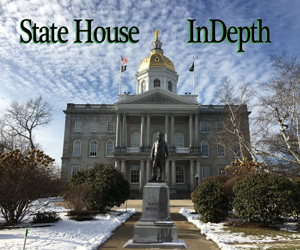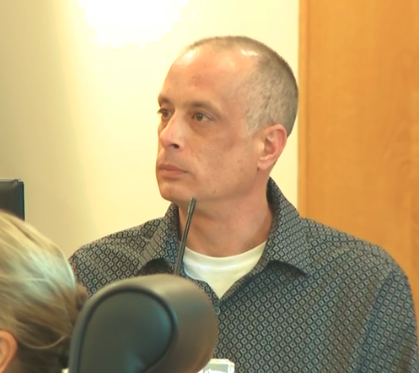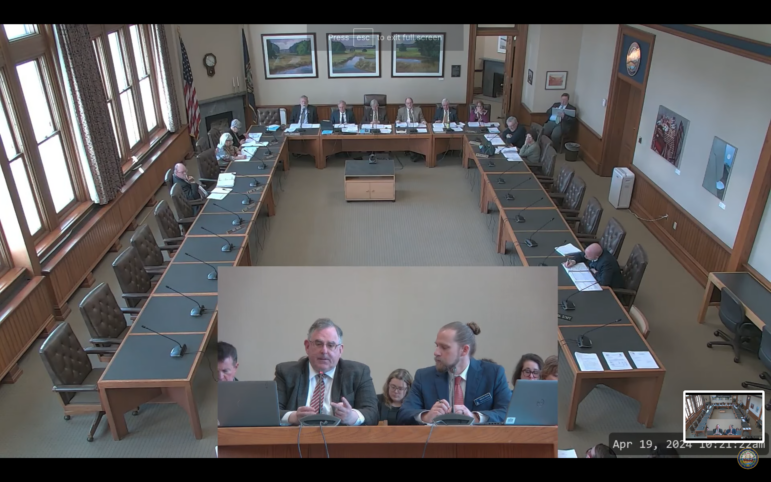 By GARRY RAYNO, Distant Dome
By GARRY RAYNO, Distant Dome
CONCORD – The Democratic intramurals over business tax rates begin this week in the House.
The House Ways and Means Committee holds a public hearing on House Bill 623 which would return the business profits tax rate to 8.5 percent while lowering the business enterprise tax rate to .5 percent or one/half percent.

Garry Rayno
Since 2016, the rates of both business taxes have been reduced from highs of 8.5 percent for the business profits tax and .75 percent for the business enterprise tax.
The lowered rates were one of the prime reasons former Gov. Maggie Hassan vetoed the 2015-2016 biennial budget crafted by a Republican-controlled legislature.
At the time, Hassan predicted the reductions would blow an $80 million dollar hole in future budgets.
However, a booming economy produced business tax returns well above what was produced at the higher rates, but hundreds of millions less than what the state would have taken in at those higher rates.
Since the first reductions in 2016, the rates have been reduced twice to the current rates of 7.9 percent for the business profits tax and .675 percent for the business enterprise tax.
And the law in place includes future rate reductions if revenues continue their strong returns.
But that is at risk with the Democratic blue tsunami last November washing Republican legislative control out to sea and leaving Democrats firmly in control.
The business tax reductions have never been popular with Democrats and the business community did not ask for the last round of cuts but was certainly not opposed to lower tax bills.
With Democrats in charge, most observers believed future reductions were probably never going to materialize.
But very quickly fissures developed among Democrats over how to address the business tax rates.
Revenue foundation
Without a broad-based income or sales tax, business taxes are the foundation of the state’s revenue stream accounting for more than a third of state revenue not counting the statewide education property tax whose receipts remain at the local level.
Consequently both Democrats and Republicans know you cannot make major changes to the two business taxes without significant adjustments to the entire revenue system.
Many progressive Democrats want business tax rates returned to their prior levels while moderate Democrats warn about increasing taxes, which a rate increase would be.

House Speaker Steve Shurtleff
House Speaker Stephen Shurtleff said he would not support tax increases and Senate Finance Committee chair Sen. Lou D’Allesandro of Manchester echoed the sentiment, saying he would support eliminating further reductions in rates but not back a return to higher rates.
Dems disagree
However the chair of the House Ways and Means Committee, Rep. Susan Almy, D-Lebanon, disagreed saying the rates should be returned to the higher level.
She is the prime sponsor of House Bill 623 which would return the business profits tax rate to 8.5 percent, but would lower the business enterprise tax rate to .5 percent, the rate approved in the education funding package lawmakers created to address the state Supreme Court’s Claremont education decisions.
Almy’s bill, which is cosponsored by many progressive Democrats, would also end future reductions to the tax rates.
According to the state’s fiscal year 2018 Comprehensive Annual Financial Report, the two business taxes produced $781.1 million, an increase of about $140 million over fiscal year 2017.
The Legislative Budget Assistant’s Office said it is difficult to determine how the proposed changes would affect revenue.

Rep. Susan Almy
But the LBA said in general — using a slightly lower figure of $776 million, which is the unaudited number in the June revenue report — Almy’s bill would increase business tax revenues about $7 million in fiscal year 2020, $17.6 million in 2021, $52 million in 2022 and $59 million in 2023.
Wednesday hearing
The public hearing Wednesday, which is at 10 a.m. in Room 202 of the Legislative Office Building, should produce engaging testimony and a few awkward moments depending on how many other Democrats oppose or support her bill.
The bill is likely to have an uphill climb in the House with the leadership opposed and no GOP support. And it surely would not make it through the Senate.
However, by introducing the bill, Almy has created an opening — however narrow — to breath some life into business tax increases.
Who knows what the economy looks like in June, especially if the federal government shutdown continues for some time?
There may be more incentive at that time for lawmakers to consider increasing revenues.
Utility Property Tax
One of the mainstays of the new education funding system lawmakers created to address the Claremont education lawsuit at the end of the last century was the statewide education property tax, which produces $363 million that remains with local communities, never collected by state government.
When it was instituted, the rate was $6.60 per $1,000 of equalized valuation, but soon donor towns — those who at that rate collected more money than they needed to fund their schools — began an effort to stop sending the extra money to Concord to be distributed to property poor communities.
The term “donor towns” was a public relations home run creating sympathy for what really are property rich communities that can easily raise money for public education while maintaining low property tax rates.
The donor towns were successful in reducing the rate so fewer and fewer communities were paying money into the state. The rate is now just above $2 per $1,000. Eventually the state decided the few towns that still had “extra money” could keep it.
What did not receive the same scrutiny was the statewide utility education property tax.
It was assessed at the same rate as the statewide property tax — $6.60 per $1,000 — but never reduced.
The statewide utility tax was intended to take tax money from communities with power plants or other major utility infrastructure and use it to pay for education.
Communities with large power plants such as Seabrook, Bow, Newington and Portsmouth had very low tax rates because of the value of the power plants.
What the utility tax did was take millions of dollars from local communities and make it state revenue.
Shifting dollars
It turned two “donor towns” into receiver towns because of the dramatic shift in dollars from local tax rolls into state coffers, particularly the education trust fund.
Full disclosure, I lived in Bow when the tax was instituted and the end result from the tax and the state’s assessment of the power plant’s value tripled my property taxes in five years.

Sen. Jeb Bradley, R-Wolfeboro
Low-tax Bow is now high-tax Bow and the same is true of Seabrook. Newington and Portsmouth have more diverse tax bases and while they lost significant local tax dollars, the impact was not as severe.
This week, the Senate Ways and Means Committee will hold a hearing on a bill to reduce the rate of the utility property tax and eliminate it by the year 2024.
Currently the utility property tax raises $41.8 million, not just from the power plants but also from power and telephone lines, substations, and other utility infrastructure.
Senate Bill 57 is sponsored by Sen. Jeb Bradley, R-Wolfeboro, and will be heard at 9:15 a.m. Wednesday in Room 100 of the State House.
Garry Rayno may be reached at garry.rayno@yahoo.com
Distant Dome by veteran journalist Garry Rayno explores a broader perspective on the State House and state happenings. Over his three-decade career, Rayno covered the NH State House for the New Hampshire Union Leader and Foster’s Daily Democrat. During his career, his coverage spanned the news spectrum, from local planning, school and select boards, to national issues such as electric industry deregulation and Presidential primaries. Rayno lives with his wife Carolyn in New London.





